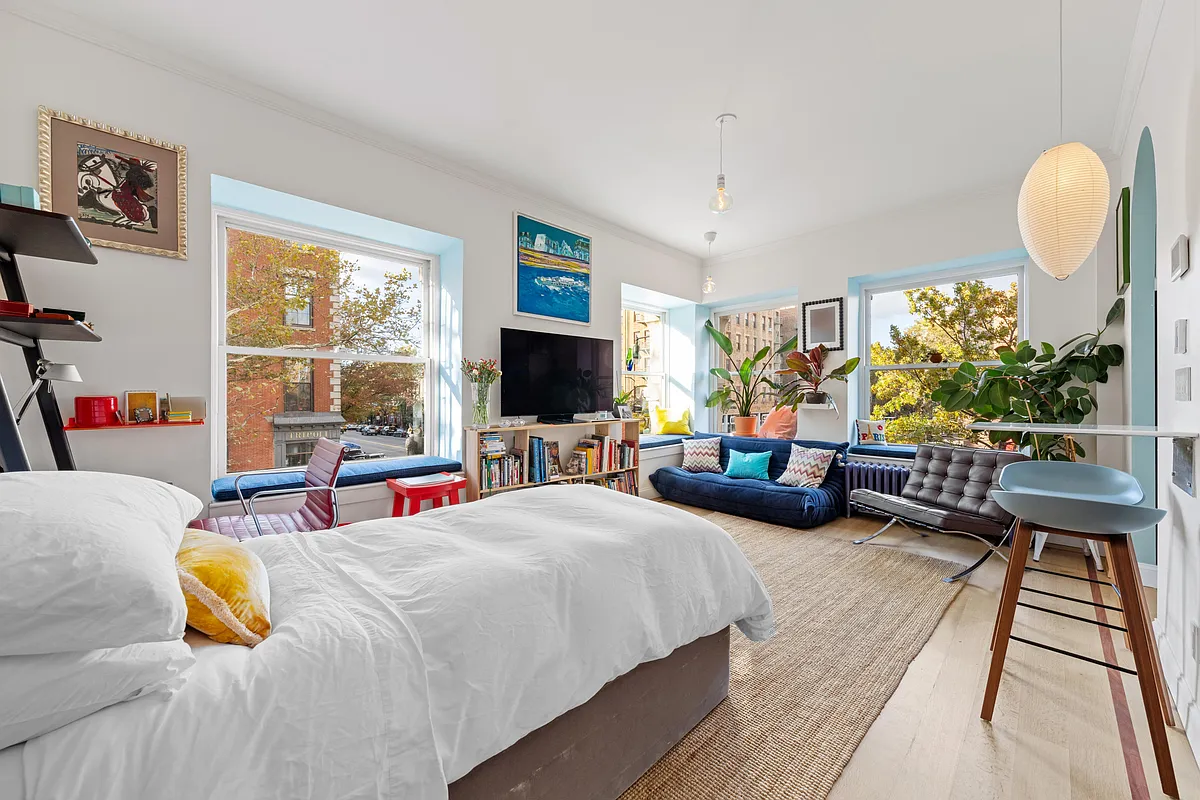House of the Day: 392 Waverly Avenue
Flip-o-rama! This attractive three-story brick house on Waverly between Gates and Greene was picked up by the current owner last summer for $985,000. After, presumably, some cosmetic (and possibly more) improvements, it’s back on the market at $1,595,000. Hey, why not? The parlor floor of this two-family house is just a few steps up from…


Flip-o-rama! This attractive three-story brick house on Waverly between Gates and Greene was picked up by the current owner last summer for $985,000. After, presumably, some cosmetic (and possibly more) improvements, it’s back on the market at $1,595,000. Hey, why not? The parlor floor of this two-family house is just a few steps up from street-level, making the “English basement” a bit of a stretch. As for the interiors, there are some nice old details and floors intact; we also can’t get our heads around why a flipper would put in such weird sinks when a classic porcelain pedestal would have done the trick. And the asking price of $1,595,000? Possible, but we think probably overshooting by a hundred grand or so.
392 Waverly Avenue [Brooklyn Properties] GMAP P*Shark





KATHLEEN PERKINS IS A SLEEZY BLACK DICK SUCKER.
So did anyone go see the house?
We bought a house from a flipper who never lived in the house, and this flipper did exactly what 10:23 has been talking about. Cosmetic renos (not as high-end as these though) without updating the mechanicals. Nobody should assume everyone who sells quickly or within 2 years is a “flipper” – but if the seller has never lived in the house, that’s certainly a clue to check out the mechanicals thoroughly. Why the debate over that, 6:42? It’s common sense.
6:42–
Do you really mean to suggest that a buyer shouldn’t think about these things? While it is true that any old house may have problems behind the walls and that a homeowner may cut corners in a renovation, it would seem that the incentives are different. Would a homeowner who plans to live in a house after renovation have the same personal and financial incentive as a flipper to splurge on a high end finish while ignoring more basic problems? Different people may come up with different answers to that question, but I am hardly ashamed for thinking about it and discussing it.
Nonetheless, you misinterpret my thread. I did not and do not suggest that such is the rule, rather than the exception, in a renovate to flip situation. All I did was pose several possible meanings behind a heavily styled high end finish in a flip situation, one of which was the possibility that the flipper wanted to create an impression of higher end work across the board than was actually done. Are you prepared to swear up and down that that never happens?? I also suggested in one of my posts, as others did, that maybe the flipper got a deal on those particular fixtures (a good thing, if you like the fixtures, with no negative implications for the reno job), and I did suggest the possibility that the bathroom is reflective of an overall quality job. All of these, including the impression management possibility were posed by me as exactly that — possibilities. All of us discussants on this site — whether owners, would-be owners, contractors, brokers, developers, flippers, etc. — are using this site as a way to understand the meaning of events in the Brooklyn market. Do you mean to suggest that it is dangerous for someone to suggest that a buyer look at the choices a flipper made and try to interpret what those choices might be telling them about the house??
1:48pm. You are simply dead wrong. You don’t have the fact but nonetheless you injected something into this thread that is potentially very damaging to the seller. Yes, flipper at times do cut corners, but many do not. Conversely, I know many permanent home purchasers who cut corners because they were seriously constricted financially and didn’t think that that certain items needed their utmost attention and consideration. If you want to, every sale can be questioned in terms of the quality of renovations behind the “walls”. But your assertions are blatantly offensive and conclusory. You should be ashamed!
Anon 1:12,
I am not casting aspersions as to the renovation of this particular house, and I make no claim whatsoever as to the quality — good or bad — of the renovation. In general, a flipper has an incentive to get the most return for the least investment. I’m sure many do the right thing when confronted with old wiring, dry rot, etc. But there is much that can be wrong/go wrong in an old house that a buyer cannot see and wehich an unscrupulous flipper may choose not to remedy upon discovery.
I began in this thread by posting a query as to why a flipper would make such individualized and unique (ok, in my view, slightly weird) design choices that might turn off buyers. It clearly stands out and yells “this is a renovated house!” Given that the fixtures and look are fairly high end, I, and others in this thread, batted around questions concerning the purpose and value of such choices. Other posters commented on the quality of the building at earlier points in time. My comments simply go to the question of what should a potential buyer make of the finish and why would the flipper commit to it. Is it part of an overall high end reno, or is it merely there to suggest to the buyer that a high end reno was done when the flipper may (I say this generically, with no knowledge as to this specific case) have taken a bunch of shortcuts with bad implications for the buyer down the road. If true, it wouldn’t be the first time that a buyer was in for a nasty surprise that was not evident upon inspection prior to closing.
Sorry to get all legal with the disclaimers; I just wanted to be clear in response to the query. Please, everyone, if you are interested, go see it for yourself and draw your own conclusions. I have no personal interest whatsoever in the actual outcome and make no — I repeat, no — representations whatsoever about this particular house, which I have never seen in person, and my comments are not meant to suggest an opinion as to this house to the contrary.
Whew.
Anon 12:40, You seem to be saying that you have suspicions that the flipper did sloppy work, or worse yet, no work aside from slapping together the kitchen and bathrooms. What are you basing this on? The timeframe of the flip? Have you actually seen the house? How about the Adelphi house and how long did the “reno” take on that one? I’m not doubting your suspicions, just curious.
I’m anon 4:56 and the “do no weird” oath proponent above. I think the reason people are jumping all over the waterworks bathroom is not out of fear of having to do the same with their own homes, but the suspicion that the high end design finish of the bathroom is meant to suggest an overall high-end renovation when the risk remains that the inmportant stuff was done poorly or not at all. It’s cheaper to put a high end sheen on what’s visible while failing to take care of ancient plumbing, electrical, and anything else suspect behind the walls, in the basement, on the roof, etc, then it is to do the important work right and put up a more moderately priced finish. Bear in mind, a home inspector is generally not responsible for what s/he can’t see. If I am buying a new renovation, I would like to be fairly secure that I’m not goin gto be reopening walls within a year to fix all the stuff the flipper couldn’t be bothered with. Conversely, if I need to rip open the walls, I don’t want to pay the renovation premium; I may as well buy a house that needs TLC, put the savings into restoring/renovating and pick the finish details myself. So the issue with the aterworks bathroom is whether it is a mask or a true representation of the care that went into the overall reno, because it’s priced as if it underwent a quality reno of the kind one would expect based upon the bathroom and kitchen finish.
what did she end up getting for the Adelphi house?